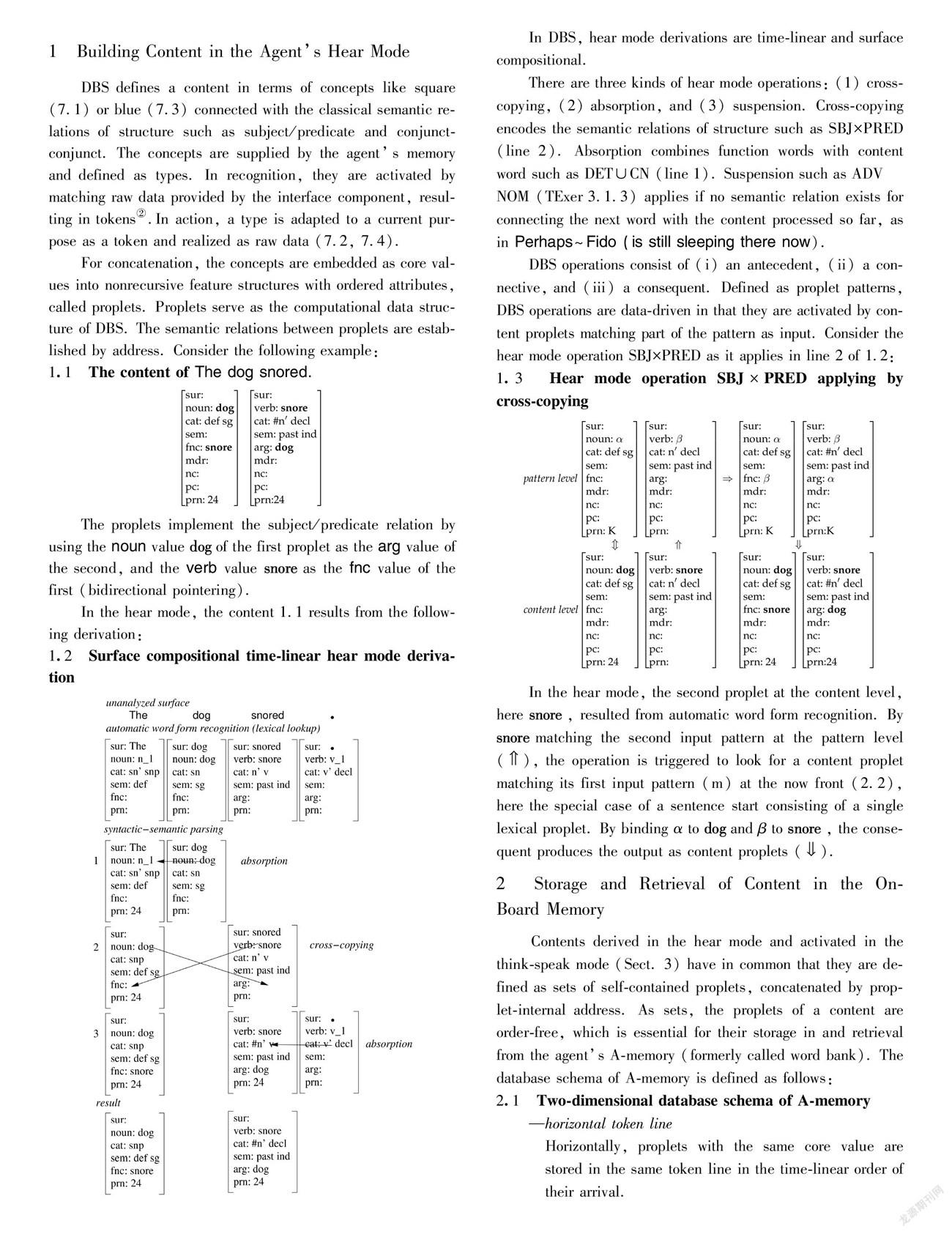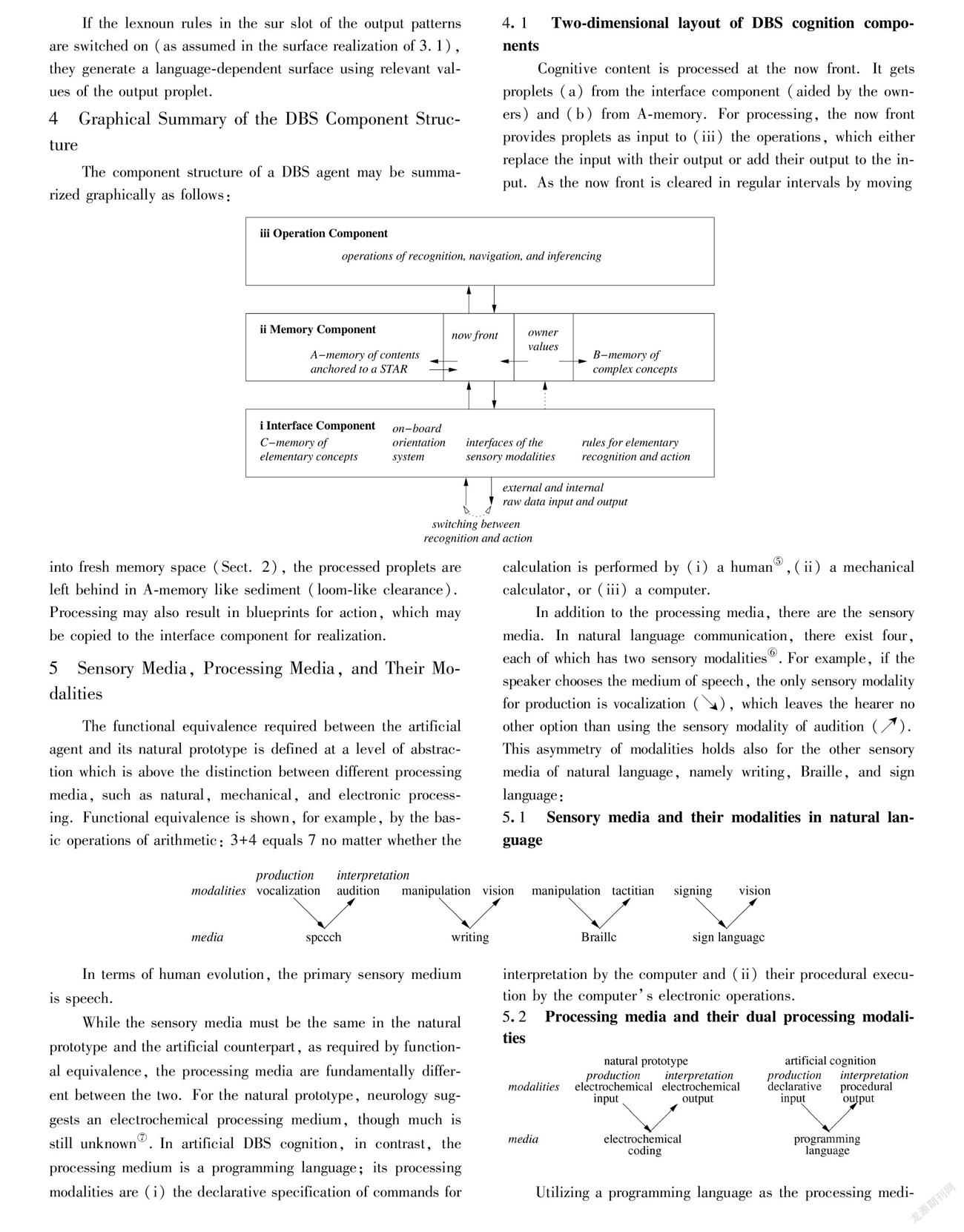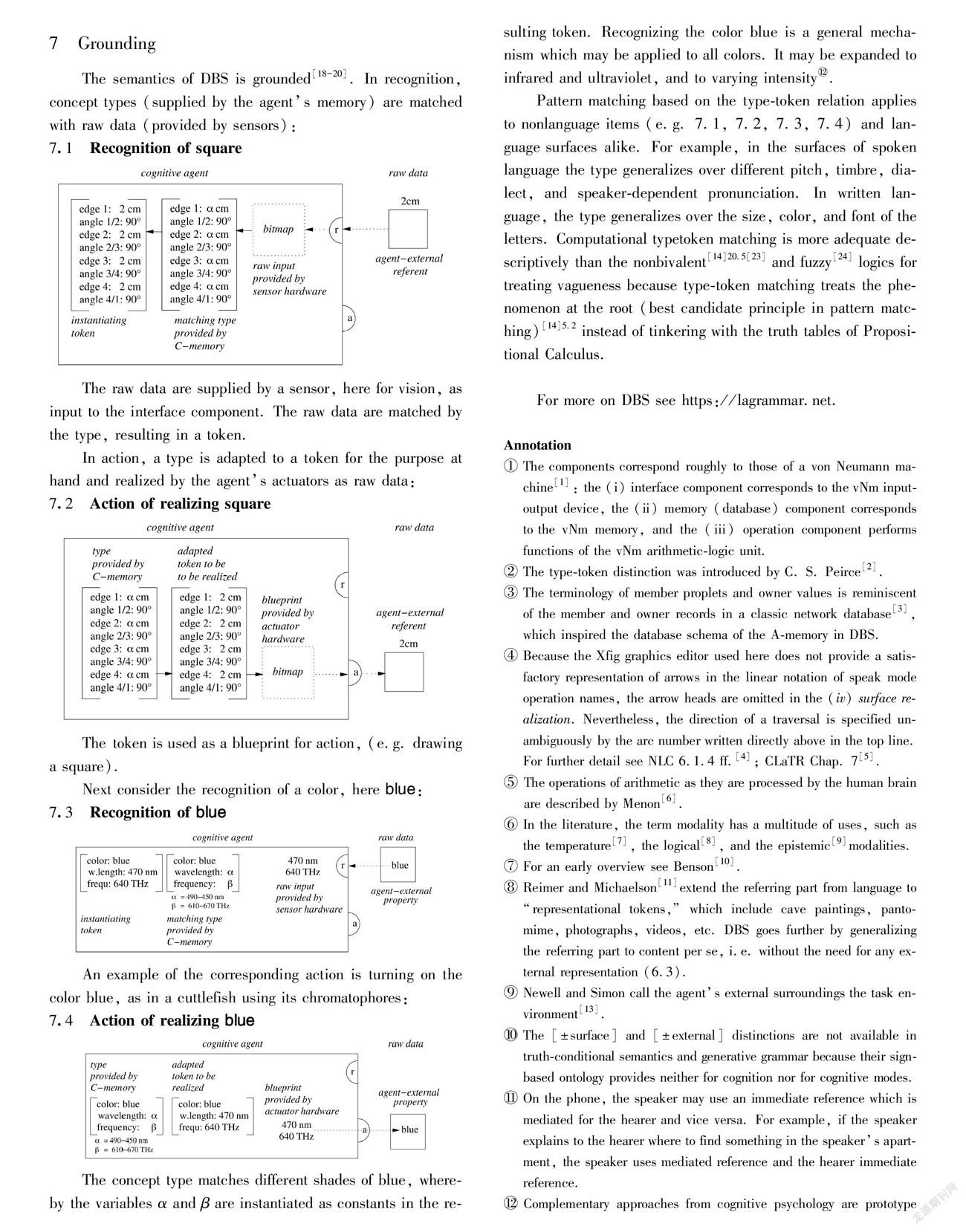数据库语义学纲要(英文,具中文摘要)
罗兰德•豪塞尔






Outline of Database Semantics (DBS)
Roland HAUSSER
(Universitt Erlangen-Nürnberg, Bavaria, Germany)
Abstract: Database Semantics (DBS) models the cycle of natural language communication as a transition from the hear to the think to the speak and back to the hear mode (turn taking). In contradistinction to the substitution-driven sign-based approaches of truth-conditional semantics and phrase structure grammar, DBS is data-driven and agent-based. The purpose is a theory of semantics for an autonomous robot with language. Propositions are content in DBS, instead of denoting truth values (Sects. 1-3). Content is built from the semantic kinds of referent, property, and relation, which are concatenated by the classical semantic relations of structure, i.e. functor-argument and coordination. To enable reference as an agent-internal cognitive process, language and nonlanguage contents use the same computational data structure and operation kinds, and differ mostly in the presence vs. absence of language-dependent surface values. DBS consists of (i) an interface, (ii) a memory, and (iii) an operation component①.The interface component mediates between the agent’s cognition and its external and internal environment, represented as raw data provided by sensors and activators (Sects. 4-7). The data of the agent’s moment by moment monitoring are stored at the memory’s now front. As part of the on-board control unit, the now front is the location for performing the procedures of the operation component, resulting in content.
Keywords: data structure; data base schema; pattern matching; turn taking; type-token; grounding; sensory and processing media and modalities; reference
摘 要:數据库语义学(Database Semantics,DBS)将自然语言交流的周期构建为从听觉过渡到思维再过渡到说话,然后从说话返回到听觉的模式(这是一个循环模式)。与真值条件语义学和短语结构语法使用的替换驱动和基于符号的方法不同,数据库语义学是数据驱动的和基于智能代理的。其目的是为具有语言能力的自主机器人提供一种语义学理论。在数据库语义学中,命题是表示内容的,而不是表示真值的(第1—3节)。内容由指称、属性和关系等语义类建立起来,它们由经典的结构语义关系,即函子论元和协调关系串联而成。为了使指称成为一个智能代理内部的认知过程,语言和非语言的内容都使用了相同的计算数据结构和操作种类,而它们之间的主要区别在于是否存在与语言相关的表面值。数据库语义学包括三部分:(i)一个交互界面,(ii)一个存储器,(iii)一个操作组件。交互界面部分在智能的认知与其外部和内部环境之间进行协调,表示为由传感器和激活器提供的原始数据(第4—7节)。智能代理每时每刻的监测数据都被存储在存储器的前端。作为智能代理控制单元的一部分,存储器的这个前端就是执行操作组件程序的位置所在,它是在内容中产生的。
关键词:数据结构;数据库图式;模式匹配;循环模式;类符-形符;基础;感觉、处理媒体和情态;指称
中图分类号:H08;H030;TP392 文献标识码:A DOI:10.12339/j.issn.1673-8578.2022.03.002
收稿日期:2022-04-24 修回日期:2022-05-18
Bibliography
[1] NEUMANN J V. First Draft of a Report on the EDVAC[J]. IEEE Annals of the History of Computing, 1945: 27-75.
[2] PEIRCE C S. The Collected Papers of Charles Sanders Peirce [C]. HARTSHORNE C, WEISS P (eds.). Cambridge, MA: Harvard Univ. Press, 1931—1935, 4:537.
[3] ELMASRI R, NAVATHE S B. Fundamentals of Database Systems[M]. 1st ed(1989)—7th ed (2017). Redwood City, CA: Benjamin-Cummings.
[4] HAUSSER R. A Computational Model of Natural Language Communication: Interpretation, Inference, and Production in Database Semantics[M]. Berlin: Springer-Verlag, 2006.
[5] HAUSSER R. Computational Linguistics and Talking Robots: Processing Content in Database Semantics[M]. Berlin: Springer-Verlag, 2011.
[6] MENON V. Developmental cognitive neuroscience of arithmetic: implications for learning and education[J]. ZDM (Zentralblatt für Didaktik der Mathematik). 2011, 42(6):515-525.
[7] DODT E, ZOTTERMAN Y. The Discharge of Specific, Cold Fibres at High Temperatures[J]. Acta Physiologica Scandinavica, 1952, 26(4): 358-365.
[8] MARCUS R B. Modalities and Intensional Languages[J]. Synthese, 1961, 13(4):303-322.
[9] KIEFER F. Two kinds of epistemic modality in Hungarian[C]//GUENTCHVA Z(ed.). Empirical Approaches to Language Typology, 2018, DOI: 10.1515/9783110572261-013.
[10] BENSON D F. The Neurology of Thinking[M]. New York: OUP, 1994, https://doi.org/10.1002/ana.410360535.
[11] REIMER M, MICHAELSON E. Reference[J/OL]. Stanford Encyclopedia of Philosophy Archive, Winter 2014 Edition.http://plato.stanford.edu/archives/win2014/entries/reference.
[12] HAUSSER R. Computational Cognition, Integrated DBS Software Design for Data-Driven Cognitive Processing[M/OL]. 2019: i-xii, 1-237, lagrammar.net.
[13] NEWELL A, SIMON H A. Human Problem Solving[M]. Englewood Cliffs, New Jersey: Prentice-Hall, 1972.
[14] HAUSSER R. Foundations of Computational Linguistics: Human-Computer Communication in Natural Language[M]. 3rd ed. Berlin: Springer-Verlag, 2014.
[15] QUINE W V O. Word and Object[M]. Cambridge, Mass.: MIT Press,1960.
[16] AHO A V, ULLMAN J D. Principles of Compiler Design[M]. Reading, Mass.: Addison-Wesley. 1977: 47.
[17] HAUSSER R. Complexity in Left-Associative Grammar[J]. Theoretical Computer Science, 1992, 106(2):283-308.
[18] BARSALOU W, SIMMONS W K, BARBEY A K, et al. Grounding conceptual knowledge in modality-specific systems[J]. TRENDS in Cognitive Sciences, Elsevier, 2003,7(2):84-91.
[19] STEELS L. The symbol grounding problem has been solved. so what’s next?[C]//DE VEGA M. Symbols and Embodiment: Debates on Meaning and Cognition, Oxford: Oxford University Press, 2008.
[10] SPRANGER M, LOETZSCH M, PAUW S. Open-ended Grounded Semantics[EB/OL]. 2010. https://csl.sony.fr/wp-content/themes/sony/uploads/pdf/spranger-10b.pdf.
[21] ROSCH E. Cognitive representations of semantic categories[J]. J. of Experimental Psychology, 1975, General 104:192-253.
[22] BIEDERMAN I. Recognition-by-components: a theory of human image understanding[J]. Psychological Review, 1987, 94:115-147.
[23] RESCHER N. Many-valued Logic[M]. New York: McGraw-Hill, 1969.
[24] ZADEH L. Fuzzy sets[J]. Information and Control, 1965, 8:338-353.
Author Introduction:
Roland Hausser (1946—),studied computational linguistics at the University of Texas at Austin and graduated with a Ph.D.(1970—1974),taught at the Ludwig-Maximilians University in Munich, and obtained a Dr. phil. habil.(1974—1983), stayed at the Universities of Pittsburgh and Stanford supported by a five year Heisenberg grant (1983—1988). In 1989, Hausser founded the Laboratory of Computational Linguistics at the University Erlangen-Nuernberg (CLUE). Among his numerous publications is the textbook “Foundations of Computational Linguistics” (FoCL), now in its third edition. For a more detailed vita see lagrammar.net. E-mail: rolandhausser662@gmail.com.

